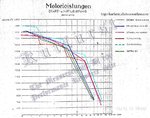wiking85
Staff Sergeant
Flugmotorenwerke Ostmark ? Wikipedia
Historically the Ostmark aeroengine factory was built to produce the Jumo 222 engine, which never ended up being produced; instead in December 1941 it was ordered to tool for the DB603 engine, which wasn't really reliable until late 1943. As it was the factory never was able to produce many DB603s, in fact Daimler Benz lost control of the factory after their failure to use even a fraction of the theoretical 1000 engine per month capacity of the factory. What if instead of tooling for the DB 603 and transferring to Daimler's control, the factory stayed in Jumo's hands and was instead tooled to produce the Jumo 213? This engine was ready for serial production by Spring 1943, which put it ahead of the DB603 in terms of reliability. Historically this engine was not produced in significant numbers until 1944, due to bombing of Jumo's factories in Germany and the desire not to disrupt Jumo 211 deliveries. Here though there would be no need to disrupt 211 deliveries, so the lines could convert over in due time, while ensuring that Jumo 213s were produced in quantity by Summer 1943. Obviously it wouldn't be producing even half of the proposed 1000 units a month in 1943, as there were issues getting enough machine tools for any engine, let alone the DB603, but there would still be major capacity that could be utilized for the Jumo 213 in 1943 and 1944. It wasn't bombed significantly until July 1944 for the first time, which didn't really affect production, so until then and even after it could operate closer to capacity than most of Jumo's other production facilities, due to being outside the range of most bombing at the time. What would this mean for the Luftwaffe to have many more Jumo 213s in 1943 and in 1944, but less DB603s?
Historically the Ostmark aeroengine factory was built to produce the Jumo 222 engine, which never ended up being produced; instead in December 1941 it was ordered to tool for the DB603 engine, which wasn't really reliable until late 1943. As it was the factory never was able to produce many DB603s, in fact Daimler Benz lost control of the factory after their failure to use even a fraction of the theoretical 1000 engine per month capacity of the factory. What if instead of tooling for the DB 603 and transferring to Daimler's control, the factory stayed in Jumo's hands and was instead tooled to produce the Jumo 213? This engine was ready for serial production by Spring 1943, which put it ahead of the DB603 in terms of reliability. Historically this engine was not produced in significant numbers until 1944, due to bombing of Jumo's factories in Germany and the desire not to disrupt Jumo 211 deliveries. Here though there would be no need to disrupt 211 deliveries, so the lines could convert over in due time, while ensuring that Jumo 213s were produced in quantity by Summer 1943. Obviously it wouldn't be producing even half of the proposed 1000 units a month in 1943, as there were issues getting enough machine tools for any engine, let alone the DB603, but there would still be major capacity that could be utilized for the Jumo 213 in 1943 and 1944. It wasn't bombed significantly until July 1944 for the first time, which didn't really affect production, so until then and even after it could operate closer to capacity than most of Jumo's other production facilities, due to being outside the range of most bombing at the time. What would this mean for the Luftwaffe to have many more Jumo 213s in 1943 and in 1944, but less DB603s?

